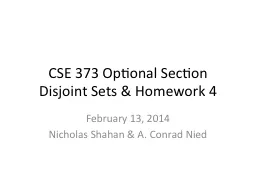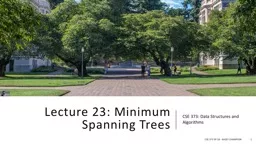PPT-CSE 373 Optional Section
Author : frostedikea | Published Date : 2020-06-30
Disjoint Sets amp Homework 4 February 13 2014 Nicholas Shahan amp A Conrad Nied Agenda Disjoint Sets Review Homework 4 Examples Disjoint Sets Review OUTBREAK trailer
Presentation Embed Code
Download Presentation
Download Presentation The PPT/PDF document "CSE 373 Optional Section" is the property of its rightful owner. Permission is granted to download and print the materials on this website for personal, non-commercial use only, and to display it on your personal computer provided you do not modify the materials and that you retain all copyright notices contained in the materials. By downloading content from our website, you accept the terms of this agreement.
CSE 373 Optional Section: Transcript
Download Rules Of Document
"CSE 373 Optional Section"The content belongs to its owner. You may download and print it for personal use, without modification, and keep all copyright notices. By downloading, you agree to these terms.
Related Documents














